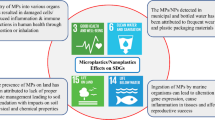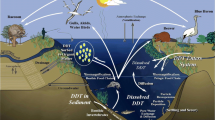Abstract
Regional serious contamination of polychlorinated biphenyls (PCBs) is threatening the local residents and ecosystem. PCBs are often very stable, but the extractable portion which is mainly responsible for their risk in sediment might be decreasing due to biodegradation and formation of non-extractable residues. In the present study, the natural reduction of extractable PCBs in regional contaminated sediments during a period of 5 years was investigated. Besides, influences of sediment organic matter on the reduction of extractable PCBs and the toxicity were studied by incubating sediments spiked with PCBs and humic acid for 5 years. The loss percentage of extractable PCBs reached 40.3%, 46.9%, 63.5%, and 70.1%, respectively in sediments at site B, C, D, and E of Nanguan River during 5 years. The sediment organic matter content was significantly correlated with the loss percentage of total PCBs (p < 0.05) and higher chlorinated PCBs (p < 0.01). In incubated sediments, significant reduction of extractable PCBs and toxicity was observed at the end of the fifth year (p < 0.05). Addition of humic acid promoted the reduction of extractable PCBs and toxicity in sediment. These results will help us to better understand the risk caused by PCBs in regional contaminated sediments over time and also provide us a possible method to enhance the reduction of extractable PCBs in contaminated sediments.




Similar content being viewed by others
References
Abramowicz, D. A. (1990). Aerobic and anaerobic biodegradation of PCBs: a review. Critical Reviews in Biotechnology, 10(3), 241–251.
Asilian, H., Gholamnia, R., Rezaee, A., Jafari, A. J., Khavanin, A., & Darabi, E. (2010). Photochemical of polychlorinated biphenyl by the photolysis and solvent. Journal of Applied Sciences and Environmental Management, 14(4), 107–112.
Bedard, D. L. (2003). Polychlorinated biphenyls in aquatic sediments: environmental fate and outlook for biological treatment. In M. M. Haggblom & I. D. Bossert (Eds.), Dehalogenation: microbial processes and environmental applications (pp. 443–465). Boston: Kluwer Academic Publishers.
Blankenship, A. L. (2000). Toxicity reference values for the toxic effects of polychlorinated biphenyls to aquatic mammals. Human and Ecological Risk Assessment, 6(1), 181–201.
Borja, J., Taleon, D. M., Auresenia, J., & Gallardo, S. (2005). Polychlorinated biphenyls and their biodegradation. Process Biochemistry, 40(6), 1999–2003.
Cheema, S. A., Imran, K. M., Shen, C., Tang, X., Farooq, M., Chen, L., Zhang, C., & Chen, Y. (2010). Degradation of phenanthrene and pyrene in spiked soils by single and combined plants cultivation. Journal of Hazardous Materials, 177(1–3), 384–389.
Chen, L., Yu, C., Shen, C., Zhang, C., Liu, L., Shen, K., Tang, X., & Chen, Y. (2010). Study on adverse impact of e-waste disassembly on surface sediment in East China by chemical analysis and bioassays. Journal of Soils and Sediments, 10(3), 359–367.
Chen, L., Tang, X., Shen, C., Chen, C., & Chen, Y. (2012). Photosensitized degradation of 2,4′,5-trichlorobiphenyl (PCB 31) by dissolved organic matter. Journal of Hazardous Materials, 201-202, 1–6.
Chen, L., Shen, C., Zhou, M., Tang, X., & Chen, Y. (2013). Accelerated photo-transformation of 2,2′,4,4′,5,5′-hexachlorobiphenyl (PCB 153) in water by dissolved organic matter. Environmental Science and Pollution Research, 20(3), 1842–1848.
Chen, L., Gao, Z., & Wang, Z. (2016). Enhanced dechlorination of 2,2′,4,4′,5,5′-hexachlorobiphenyl in water-sediment mixture by adding anthraquinone-2,6-disulfonic acid. Journal of Soils and Sediments, 16(1), 1–6.
Chu, W., Chan, K. H., Kwan, C. Y., & Jafvert, C. T. (2005). Acceleration and quenching of the photolysis of PCB in the presence of surfactant and humic materials. Environmental Science & Technology, 39(23), 9211–9216.
Doick, K. J., Burauel, P., Jones, K., & Semple, K. (2005). Distribution of aged 14C−PCB and 14C−PAH residues in particle-size and humic fractions of an agricultural soil. Environmental Science & Technology, 39(17), 6575–6583.
Field, A. J., & Sierra-Alvarez, R. (2008). Microbial transformation and degradation of polychlorinated biphenyls. Environmental Pollution, 155(1), 1–12.
Furukawa, K. (2000). Biochemical and genetic bases of microbial degradation of polychlorinated biphenyls (PCBs). The Journal of General and Applied Microbiology, 46(6), 283.
Gao, Y., Wang, Y., & Zhou, Q. (2015). Distribution and temporal variation of PCBs and PAHs in soils and sediments from an e-waste dismantling site in China. Environment and Earth Science, 74(4), 2925–2935.
Guan, H., Sheng, C., & Ming, H. (2010). Dietary exposure to PCBs based on food consumption survey and food basket analysis at Taizhou, China - the World’s major site for recycling transformers. Chemosphere, 81(10), 1239–1244.
Haitzer, M., Hoess, S., Traunspurger, W., & Steinberg, C. (1998). Effects of dissolved organic matter (DOM) on the bioconcentration of organic chemicals in aquatic organisms. Chemosphere, 37(7), 1335–1362.
Jafari, A., Heydari, J., & Keramati, A. (2017). Factors affecting incentive dependency of residents to participate in e-waste recycling: a case study on adoption of e-waste reverse supply chain in Iran. Environment, Development and Sustainability, 19, 1–14.
Karlsson, J., Jansson, M., & Jonsson, A. (2002). Similar relationships between pelagic primary and bacterial production in clearwater and humic lakes. Ecology, 83(10), 2902–2910.
Ma, M., Tong, Z., Wang, Z., & Zhu, W. (1999). Acute toxicity bioassay using the freshwater luminescent bacterium Vibrio-qinghaiensis sp. Nov. Q67. Bulletin of Environmental Contamination and Toxicology, 62(3), 247–253.
Northcott, G. L., & Jones, K. C. (2000). Experimental approaches and analytical techniques for determining organic compound bound residues in soil and sediment. Environmental Pollution, 108(1), 19–43.
Storer, D. A. (1984). A simple high sample volume ashing procedure for determination of soil organic matter. Communications in Soil Science and Plant Analysis, 15(7), 759–772.
USEPA. (1996). Method 3620C revision 3, soxhlet extraction www.epa.gov/epaoswer/hazwaste/test/main.htm.
USEPA. (2013). Polychlorinated Biphenyl (PCB) www.epa.gov/epaoswer/hazwaste/ tsd/pcbs/pubs/about.htm.
van der Zee, F. P., & Cervantes, F. J. (2009). Impact and application of electron shuttles on the redox (bio)transformation of contaminants: a review. Biotechnology Advances, 27(3), 256–277.
Villa, S., Vighi, M., Finizio, A. (2014). Experimental and predicted acute toxicity of antibacterial compounds and their mixtures using the luminescent bacterium Vibrio fischeri. Chemosphere, 108, 239–244.
Wiegel, J., & Wu, Q. (2000). Microbial reductive dehalogenation of polychlorinated biphenyls. FEMS Microbiology Ecology, 32(1), 1–15.
Zhang, D., Zhang, N., Yu, X., Zhang, Z., Yang, S., & Zhang, C. (2017). Effect of humins from different sediments on microbial degradation of 2,2′,4,4′,5,5′-hexachlorobiphenyl (PCB153), and their polyphasic characterization. RSC Advances, 7(12), 6849–6855.
Funding
This work was supported by the National Natural Science Foundation of China (No.41301545) and the Priority Academic Program Development of Jiangsu Higher Education Institutions Fund.
Author information
Authors and Affiliations
Corresponding author
Additional information
Publisher’s Note
Springer Nature remains neutral with regard to jurisdictional claims in published maps and institutional affiliations.
Rights and permissions
About this article
Cite this article
Chen, L., Wang, Z. Enhanced Reduction of Extractable Polychlorinated Biphenyls and Toxicity in Sediment by Organic Matter. Water Air Soil Pollut 229, 400 (2018). https://doi.org/10.1007/s11270-018-4050-4
Received:
Accepted:
Published:
DOI: https://doi.org/10.1007/s11270-018-4050-4




